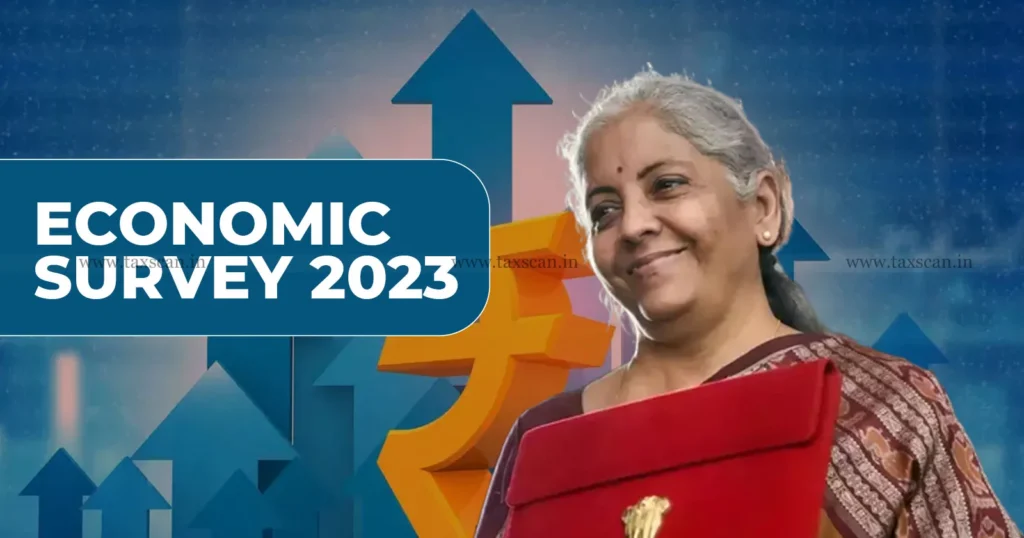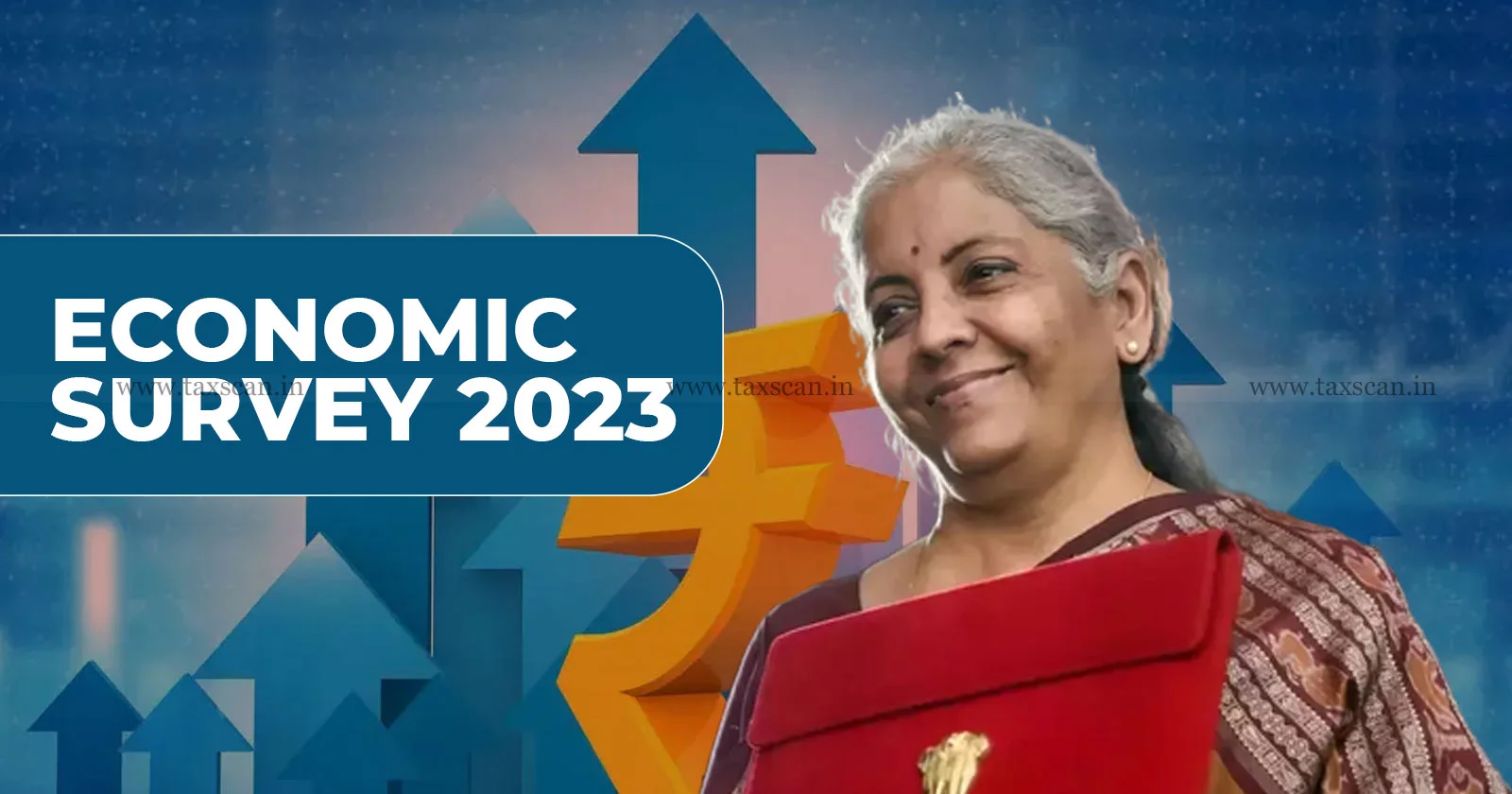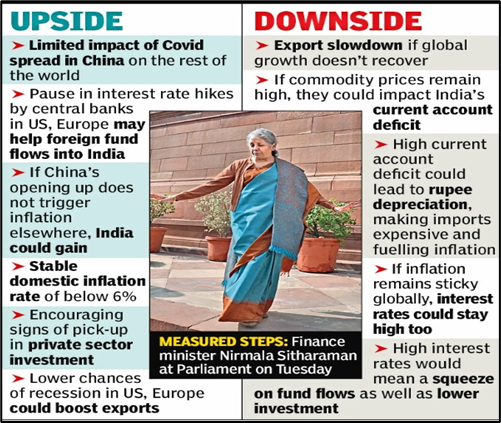
Why in news?
- On 31 January, the government tabled the Economic Survey 2022-23. The Survey laid out the outlook for India’s growth, inflation and unemployment in the coming years.
What’s in today’s article?
- Economic Survey
- Key Takeaways
Economic Survey
- The Economic Survey of India is an annual report released by the Finance Ministry. It details the state of the economic performance of the country in the past year.
- The survey highlights macroeconomic figures and economic progress of the country.
- It also mentions the possible economic challenges that India might face in future and suggests measures to overcome them.
- The survey is prepared by the Economic Division of the Department of Economic Affairs in the Ministry of Finance under the supervision of the Chief Economic Advisor of India (CEA).
- The Economic Survey of India is presented every year a day before the Union Budget is announced.
- This year’s survey was presented by the CEA V Anantha Nageswaran, after being tabled by Finance Minister in the parliament.
Economic Survey 2023: Key Takeaways
- GDP growth
- The Survey said India’s growth estimate for FY23 is higher than for almost all major economies.
- It projected the economy to grow by somewhere between 6% -6.8%, depending on global factors in 2023-24, with 6. 5% a baseline expectation.
- Despite global uncertainties and slowing world economy, India’s growth is supported by solid domestic demand and a pickup in capital investment.
- India’s projected growth rate, that too without the advantage of a base effect, is a reflection of India’s underlying economic resilience.
- Indian economy in 2022-23 has nearly:
- recouped what was lost,
- renewed what had paused, and
- re-energised what had slowed during the pandemic and since the conflict in Europe.
- The survey also highlighted few downside risks which might affect the growth:
- Low demand for Indian exports due to poor global growth may widen India’s trade deficit and make the rupee depreciate.
- Also, sustained monetary tightening (higher interest rates) may drag down economic activity in FY24.
- Inflation
- The RBI has projected headline inflation at 8% in FY23, outside its comfort zone of 2% -6%.
- The Survey sounded optimistic about the inflation levels and trajectory as both wholesale and retail inflation are on the descending slope.
- However, any re-emergence of Covid-19 situation in China or a reversal of slump in commodity prices poses risks to the inflation trajectory going ahead.
- Unemployment
- The Survey said employment levels have risen in the current financial year.
- It pointed to the Periodic Labour Force Survey (PLFS), which showed that urban unemployment rate for people aged 15 years and above declined from 9.8% in the quarter ending September 2021 to 7.2% one year later.
- The Survey also underlined that the fall in unemployment rate is accompanied by an improvement in the labour force participation rate.
- Capital expenditure (capex) target
- Capital expenditure has started to stimulate private investment, and the budget target of ₹7.5 lakh crore for the current fiscal year is expected to be met.
- Strong domestic demand and a pickup in capital investment will support the country’s growth trajectory in FY24.
- There is an expectation of a recovery in private capex, driven by improved balance sheets, resurging credit, and the crowding in from public capex.
- The survey said that the government’s thrust on capex, particularly in the infrastructure-intensive sectors like roads and highways, railways, and housing and urban affairs, has longer-term implications for growth.
- PM Gati Shakti has additionally assisted in accelerating infrastructure development.
- Foreign Direct Investment (FDI) inflows
- Due to India’s rapid economic growth and enhanced business environment, FDI into the nation is anticipated to increase in the upcoming months.
- According to data from the Department for Promotion of Industry and Internal Trade (DPIIT), FDI equity inflows into India decreased by 14% to USD 26.9 billion over the period from April to September this fiscal.
- Current Account Deficit (CAD)
- The need for careful monitoring of the current account deficit, which could continue to grow due to elevated global commodity prices, was emphasised.
- The country’s current account deficit increased to 4.4% of GDP in the quarter ending in September from 2.2% of GDP during the April-June period (RBI Data).
- Rupee likely to remain under depreciation pressure
- The pressure on the Indian rupee’s depreciation may continue as a result of the export market’s slowing and the subsequent expansion of the current account deficit.
Sectoral pointers from survey
- Regulating crypto ecosystem
- The recent collapse of the cryptocurrency exchange FTX and the ensuing sell-off in the crypto markets have placed a spotlight on the vulnerabilities in the crypto ecosystem.
- Crypto assets are self-referential instruments and do not strictly pass the test of being a financial asset because it has no intrinsic cashflows attached to them.
- EV Market may cross 1-crore sales
- India’s Electric Vehicle (EV) market is expected to grow to 1-crore units annual sales by 2030 and create 5 crore direct and indirect jobs.
- In December 2022, India became the third-largest automobile market, surpassing Japan and Germany in terms of sales.
- 5G can unleash new eco avenues
- The rollout of 5G services can unleash new economic opportunities and help India leapfrog the traditional barriers to development, while boosting innovations by startups and business.
Suggestions given by Survey
- The Survey has called for:
- entirely dismantling the LIC (licensing, inspection and compliance) regime to accelerate economic growth,
- harnessing women power (nari shakti),
- renewed focus on energy security and energy transition, education and skilling, administrative reforms.
- The survey sought determined efforts to make public sector asset monetisation scheme successful, besides addressing (by states) of the power sector issues.
- The Survey has also placed sufficient emphasis on fiscal consolidation, which it notes is critical for low interest rates in the long term





